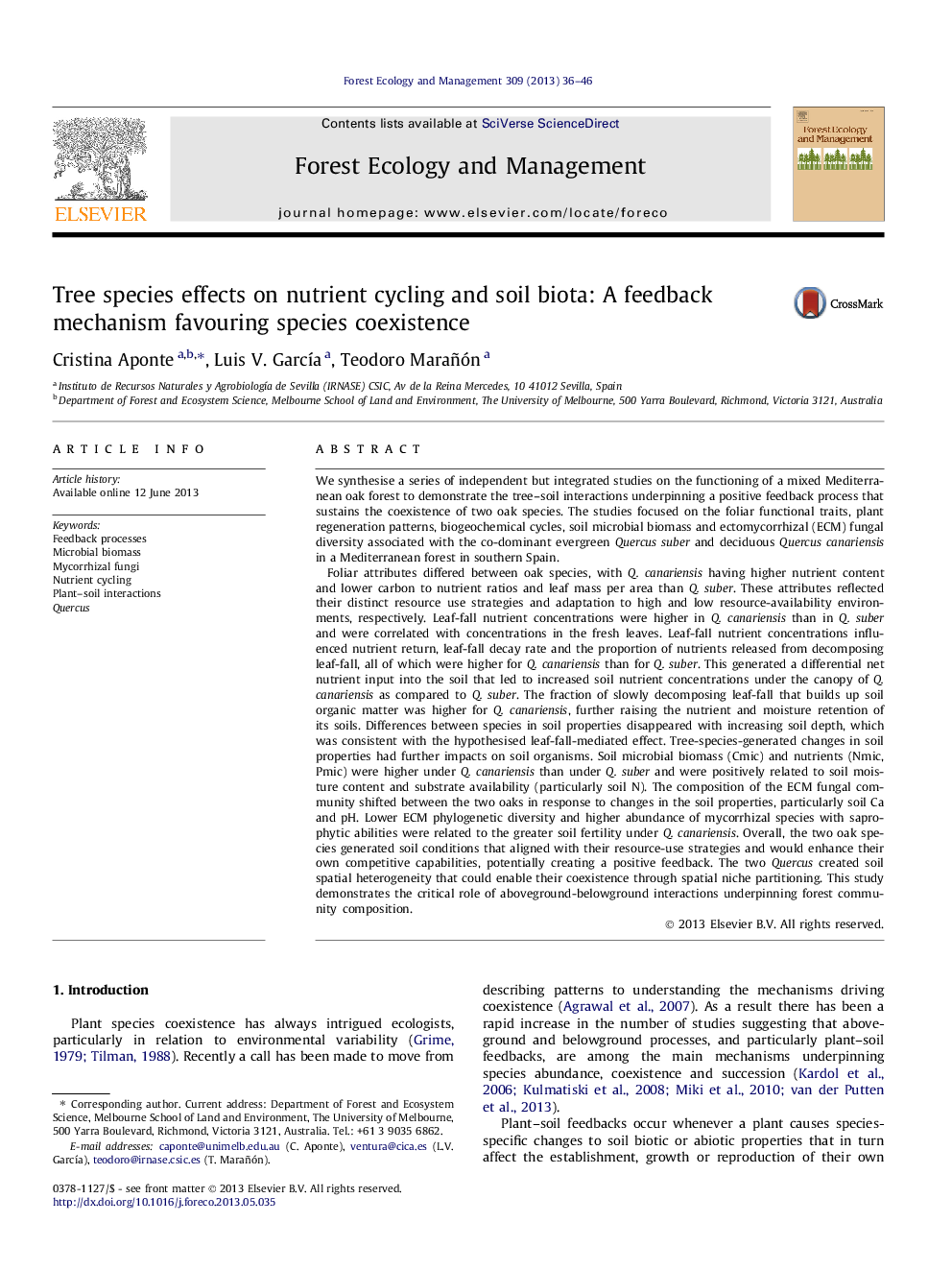| کد مقاله | کد نشریه | سال انتشار | مقاله انگلیسی | نسخه تمام متن |
|---|---|---|---|---|
| 86670 | 159205 | 2013 | 11 صفحه PDF | دانلود رایگان |

• Tree species sharply altered soil fertility through different leaf litter quality.
• Soil changes were mediated by distinct nutrient return, litter decomposition and nutrient release.
• Tree species also affected soil microbial biomass and mycorrhizal fungal community.
• Species generated soil abiotic and biotic conditions that may increase their own fitness.
• Species-generated spatial soil heterogeneity could favour their coexistence through niche partitioning.
We synthesise a series of independent but integrated studies on the functioning of a mixed Mediterranean oak forest to demonstrate the tree–soil interactions underpinning a positive feedback process that sustains the coexistence of two oak species. The studies focused on the foliar functional traits, plant regeneration patterns, biogeochemical cycles, soil microbial biomass and ectomycorrhizal (ECM) fungal diversity associated with the co-dominant evergreen Quercus suber and deciduous Quercus canariensis in a Mediterranean forest in southern Spain.Foliar attributes differed between oak species, with Q. canariensis having higher nutrient content and lower carbon to nutrient ratios and leaf mass per area than Q. suber. These attributes reflected their distinct resource use strategies and adaptation to high and low resource-availability environments, respectively. Leaf-fall nutrient concentrations were higher in Q. canariensis than in Q. suber and were correlated with concentrations in the fresh leaves. Leaf-fall nutrient concentrations influenced nutrient return, leaf-fall decay rate and the proportion of nutrients released from decomposing leaf-fall, all of which were higher for Q. canariensis than for Q. suber. This generated a differential net nutrient input into the soil that led to increased soil nutrient concentrations under the canopy of Q. canariensis as compared to Q. suber. The fraction of slowly decomposing leaf-fall that builds up soil organic matter was higher for Q. canariensis, further raising the nutrient and moisture retention of its soils. Differences between species in soil properties disappeared with increasing soil depth, which was consistent with the hypothesised leaf-fall-mediated effect. Tree-species-generated changes in soil properties had further impacts on soil organisms. Soil microbial biomass (Cmic) and nutrients (Nmic, Pmic) were higher under Q. canariensis than under Q. suber and were positively related to soil moisture content and substrate availability (particularly soil N). The composition of the ECM fungal community shifted between the two oaks in response to changes in the soil properties, particularly soil Ca and pH. Lower ECM phylogenetic diversity and higher abundance of mycorrhizal species with saprophytic abilities were related to the greater soil fertility under Q. canariensis. Overall, the two oak species generated soil conditions that aligned with their resource-use strategies and would enhance their own competitive capabilities, potentially creating a positive feedback. The two Quercus created soil spatial heterogeneity that could enable their coexistence through spatial niche partitioning. This study demonstrates the critical role of aboveground-belowground interactions underpinning forest community composition.
Figure optionsDownload as PowerPoint slide
Journal: Forest Ecology and Management - Volume 309, 1 December 2013, Pages 36–46